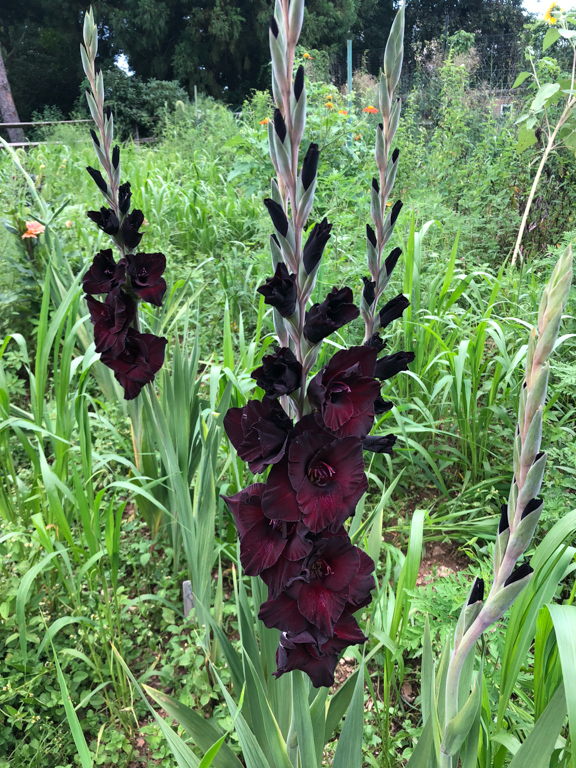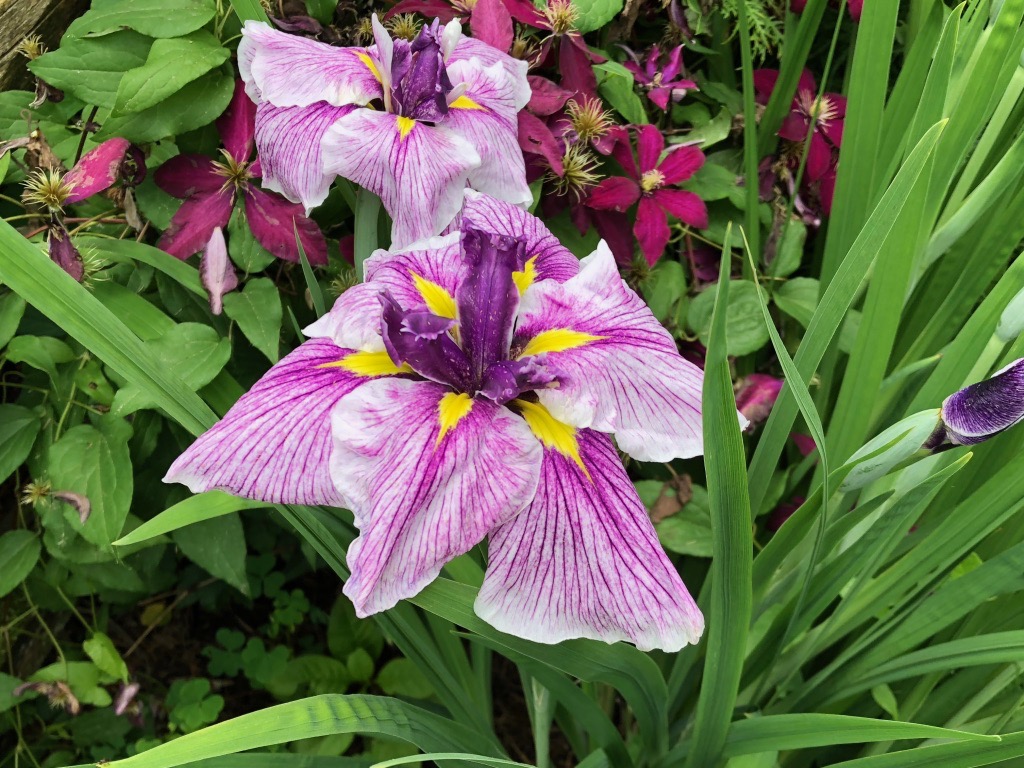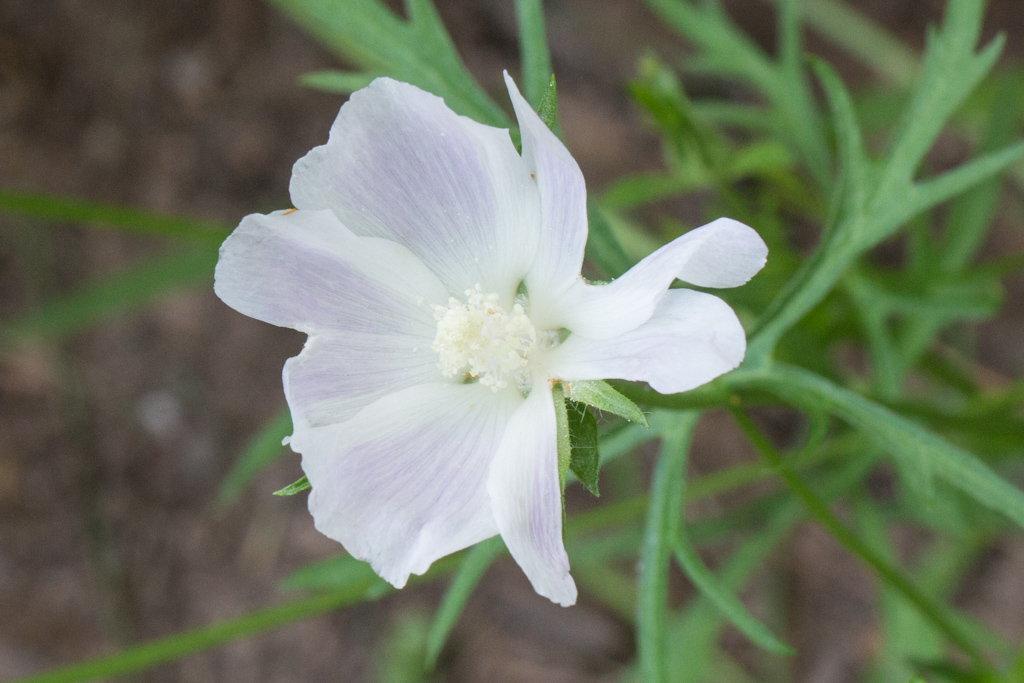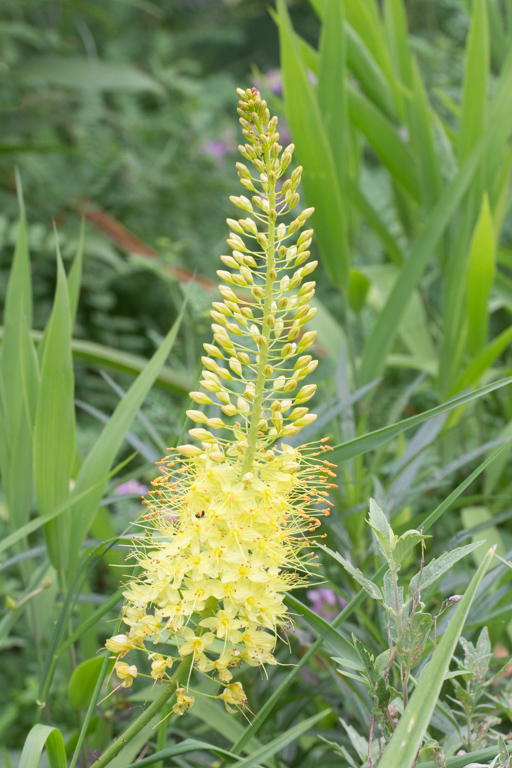
Dahlia in the house
Well it’s Bloom Day for September and the weather has been spectacular the past week. There are a great many annual flowers in the garden such as zinnias, cosmos, nasturtium, calendula, and daisies. I’ll just represent them all with the this big Dahlia that Beth brought into the house. And then maybe Tithonia (Mexican Sunflower) since it has grown to spectacular heights (at least 12 feet) this year.

Tithonia
Another annual that has grown on our porch this year is Plectranthus. It was overwintered in the greenhouse and then took a while to catch hold in the spring. But it now looks spectacular (and it makes a good cut flower in the house as well).

Plectranthus ‘Mona Lavender’

Plectranthus ‘Mona Lavender’ in detail
Another back porch item is the Princess Flower which continues its daily vivid flowers

Princess Flower (Tibouchina urvilleana)
At the front porch is the very green welcoming garden that Beth built with deep black rectangles.

Entrance Garden
And a particularly striking addition this year is a Carex with pink flowers that we brought back from Plant Delights this spring.

Carex scaposa
From the greenhouse comes a very striking hyacinth relative from Madeira.

Scilla madeirensis
A few other items struck me as I walked about the yard. There are marvelous peony seeds at this time of year.

Peony Seeds
The Pyracantha and Hyacinth have intertwined to create a lovely combination.

Intertwining of pyracantha (mojave) and hydrangea (limelight)
And a newly planted Arisaema consanguinum looks for all the world like a mother hen for the neighboring Cyclamen.

Arisaema consanguinum and cyclamen hederifolium
Then there are the still good-looking repeats from last month.

Cestrum x ‘Orange Peel’

Crepe myrtle white
And I discovered that the Clematis which I tried to remove at least two other times has sprung up again among the roses.

Clematis paniculata
This is a particularly beautiful and vigorous plant that is happy to take over your garden.
And if you go for a walk on the hillside you will see the Colchicum doing their fall explosion of color.

Colchicum ‘Giant’
The other thing that happens now are berries and other fruit.

Viburnum wrightii

Fig fruit ready for picking

Potomac Pears at harvest time.
And then I’ll close with one of the workers in the greenhouse that keeps the pests at bay.

Jumping Spider in greenhouse
Garden Blogger’s Bloom Day September 2019
It’s appropriate to feature a zinnia for this Garden Blogger’s Bloom Day post because they are all over the place — in vegetable garden, by the driveway, and in the orchard. It’s hard to disagree with a flower that comes from seed so easily and lasts all season long. In fact zinnias were the first flower we planted when we got inspired to start gardening fifty years ago. We read a book by Jeanne Darlington (Grow Your Own) that led us to scratch a little garden plot next to our student housing. There have been a lot more flowers since …
Typically we have Dahlias and Glads in the vegetable garden just for picking.
And son Josh planted a lot of wildflowers around the property this spring.
Including especially zinnias and sage in the orchard, but also this particularly pretty variety of basil.
My eye tends to get distracted by the perennials, especially those that are giving a bonus rebloom.
There is also a nice little patch of Colchicum in with the wildflowers in the backyard.
As you walk down the driveway it’s hard not to notice the Viburnum with it’s berries hanging out into the drive.
In the greenhouse I found the Scilla maderensis budding up a few days ago.
And now the flowers are opening up.
This is also the oxalis time of the year.
One after another, the Oxalis break into bloom from early September into February.
I’ve also found myself reading up about Zephyranthes and their close relatives Habranthus. These are both part of the Amaryllis family and they are spectacularly easy to grow. They are often called rain lilies because the rapid appearance of the flowers in late summer. I’ve had the yellow forms (like Zephyranthes smalli and Z. jonesi, or Habranthus texensis) for a number of years, but what I’m discovering is that the pink and red forms of the family are really special.
This little Habranthus has white flowers that are tinged pink on the outside.
And these two Zephyranthes are both of the pink persuasion mixed with white.
This last one is especially large for a Zephyranthes. It was found in Mexico on a red mountain, therefore it’s name. Most of the Zephyranthes prefer a southern climate (say zone 8), but they are easy to overwinter in a pot. They make abundant seeds which will start popping up in other pots if you don’t pay attention. I’ve got a number of pots that I thought were tritoma or babiana or some other bulb, only to realize that they were actually Zephyranthes volunteering to use an empty pot.
Garden Blogger’s Bloom Day August 2019
In the midst of hot days in August it is a reliable pleasure to see butterflies in great abundance throughout the garden. For this Garden Blogger’s Bloom Day posting let me begin with some shots of the butterflies that are everywhere right now in Maryland.
It’s also a good time of year to spot the Hummingbird or Clearwing Moth. They are very distinctive with almost invisible wings as the flit about the flowers.
Here are some of the standard flowers around the yard right now.
And of course the glads are still blooming in the cutting garden.
New for us in the Cestrum that we added this year.
And a little more unusual is the diminutive Anemonopsis with it’s waxy flowers.
We also take advantage of the August flowers in the house as well.
And then from the greenhouse
Lastly let me note a seeding success with these hardy camellia seedlings started from seeds purchased from Camellia Forest.
These should be interesting to grow outside in Maryland.
Garden Blogger’s Bloom Day Sept 2018
Well, it’s been a strange time for flowers on this Garden Blogger’s Bloom Day. While we have dodged the hurricane bullet that hit the folks in the Carolinas, the weather has been unusual to say the least. To date we have had over 52 inches of rain compared to the normal of 29 inches through mid-September. On the one hand we have the traditional flowers for September like the mums shown above. And some remarkable Dahlias from the garden.
But we have also had the Apples drop most of there leaves in July and August and they are now re-blooming.
Many other trees have dropped their leaves and the Azaleas out front are blooming again.
Despite the strange weather there are still a set of interesting flowers to find around the yard, for example this Roscoea.
And in the greenhouse the rather unusual large Scilla maderensis is flowering once again.
Some other items of note include this six foot tall Canna that came from a friend this year.
The Knockout Roses are continuing to bloom.
And the Perennial Pea is blooming once again despite our attempts to remove it.
We have found that Phlox also reappears from long ago planting with or without our tending to it.
And in the orchard the Blue Sage has been in continuous bloom since late spring.
Some of our outside work is getting set aside because of several nests of Yellowjackets. They took up residence in one our large pots on the deck and also in the ground by one of the raised beds. These guys seem impervious to chemicals and according to the web can be quite dangerous (not something we want to test since I for one am allergic to wasp venom) and there are hundreds of them.
Finally, let me note that this is time for packing up your seeds to send off to the various seed exchanges. By becoming a seed donor, you get first choice when you participate in the seed exchanges organizations. Check out the North American Rock Garden Society for example.
Garden Blogger’s Bloom Day August 2018
It’s been hot but with enough rain to grow the weeds and sunflowers to magnificence. So I will dedicate this belated Garden Blogger’s Bloom Day posting to the many sunflowers in the garden.
Some of them are easily ten feet tall.
But they are all wonderful for birds, bees, and humans alike.
A close namesake is the Mexican Sunflower
Tithonia are also very popular with bees, butterflies, and hummingbirds.
The vegetable garden also features gladiolus in quantity.
The glads get displayed in the house.
Along with several kinds of Cyrtanthus from the greenhouse.
Think of Cyrtanthus as smaller, more refined Amaryllis.
Also in the greenhouse right now are the little scilla relatives from Japan
In the Alpine bed we find the most recent Gentian to come into bloom.
The gentians, with the various species, span spring to fall with flowers, and all of them have delightful complex flowers.
Another little tidbit in flower right now is the anemonopsis
I have been trying to flower one of these for years and this is the first one to share it’s dainty little waxy flowers.
Out in the orchard there are zinnias around the new apple trees.
Of course gardeners do not survive on flowers alone.
That’s about it on a hot summer day. We are running 15 inches over normal for rain to this point. I’m wondering what the fall will bring…
Garden Blogger’s Bloom Day June 2018
June is a month for spectacular Iris, Clematis overflowing the fences, Roses flowering abundantly and flowers of many kinds reaching fruition. For this Garden Blogger’s Bloom Day, I’ll share some of the things that struck my eye this week.
One of the reasons for growing flowers is to attract the many butterflies that enliven the yard. And what better to grow than the different kinds of Butterfly Weed. The normal Asclepias tuberosa comes without effort in our pasture and feeds the monarchs later in the year. But in the yard we are also growing Swamp Milkweed for different kind of color.
And an extremely heavily flowered cultivar is ‘Hello Yellow’.
Here’s the evidence that Butterfly Weed is a good name.
I remembered last year that two of the Arisaemas were very slow to appear, finally showing up on June 2nd. This year Arisaema candidissimum came on May 31 and Arisaema farghesi poked out of the ground on June 2nd again. Talk about reliable.
Just walking around the yard here are some of the other flowers.
This Clematis is climbing up the huge Black Lace Elderberry.
In the alpine bed there a couple of lovely gentians that we’ve never grown before. Both are the result of seed exchanges. The Gentiana dahurica is a good 18″ high and spreading, probably to big for the alpine bed in the long run.
The Himalayan Gentian has the same delicate fringing that I like on other Gentians.
But it also has multi-colored buds that are lovely even before they’ve opened.
Nearby is the first blooming of a Stachys that came for seed last year.
And up on the porch is a spectacular bulb from Peru that is a variation on the normal Peruvian Daffodil.
I should also note that life is not just flowers at this time of year.
We’ve been bringing in a steady diet of peas, strawberries, and raspberries. And now the blueberries are about to start.
There is one other flower worth sharing though. For many people the Corydalis lutea is described as a weed, but I find it’s a wonderful fern-like spreading ground cover.
What’s growing in your garden?
Garden Blogger’s Bloom Day September 2017
Well, it’s fall here in Maryland and some of the usual suspects are providing our flowers for Bloom Day. Japanese anemone are robust and reliable, as well as incredibly beautiful.
Some of the other regulars are in the following pictures.
In the wildflower patch, the wild asters are currently the star of the show, attracting insects of all sorts.
In the cutting garden the standouts are the Tithonia.
Beth has shown they look really nice next to the Salvia ‘Black and Blue’. They are also quite tall so it’s easy to see them from underneath as well.
A similar color comes with the Atlantic Poppy which took forever to start blooming but now has a new flower every day.
Inside the greenhouse we have blooming for the first time the Scilla maderensis. It seems to open just a few of the flower elements per day so that it’s never completely in flower for us.
It is nevertheless interesting and exotic which goes a long way to getting space in the greenhouse.
The first of the Oxalis are coming into bloom now.
There are three species blooming now, but the rest will extend the blooming season into January at least.
It’s worth noting that one does not live by flowers alone. The garden fruits and vegetables have been abundant this year, pushing us to new recipes and uses for the crops…
Garden Blogger’s Bloom Day June 2017
I will lead off this very late Garden Blogger’s Bloom Day post with a lovely little anemone that came from the NARGS seed exchange three years ago. It’s not spreading but seems to be holding its own in the Monument bed.
I am always surprised that two of Arisaemas hold off until June. Their colleagues begin back in April. But just when you think that winter has finished them off, the Arisaema candidissimum and Arisaema fargesii come popping up through the ground.
It is also surprising to see the Freesia laxa return every year.
According to the books this little corm is not viable in our climate. Not only has it returned but it’s jumped the tracks and moved to another garden bed as well.
I have it growing now next to the reliable Brodiaea ‘Queen Fabiola’.
That’s a white Callirhoe in the front of the image.
And they all mix together like this.
In the same garden bed we have a bright yellow Butterfly Weed.
This is very popular with all the butterflies and bees. For example this swallowtail was cruising around the yard.
Nearby we find a lovely clematis growing up a trellis.
Also by the garage there is a marvelous foxtail lily that came from Far Reaches.
Back in the monument bed there is the first of the Asiatic lillies coming out.
And a chinese ground orchid that is a little taller than our other ground orchids.
Back in the Camellia bed, emerging through the rapidly growing Japanese Anemones is a very pretty Astrantia.
If we go back to the Alpine bed, as I do several times a day, a very nice dwarf plant in the Campanulaceae is just finishing. I cannot read the label but I suspect it’s an Edraianthus.
Just finished now is also another pasque flower.
Also in the alpine bed is a new gentian that we found at Oliver Nursery this spring.
In the greenhouse there are a few picture-worthy objects as well.
This is a two-foot tall Ornithogalum that came from the PBS bulb exchange.
Another PBS acquisition is this Pine Woods Lily.
I almost forgot to mention the Stewartia. It has been a consistent flowering tree for June 15th. This year it is loaded with flowers but only one is actually open now.
However, life is not flowers alone. It is the peak time for our berries, especially the blueberries.
It’s a joy picking blueberries. We brought in gallons last night. I’m convinced the only reason we can do so is that just behind the garden we have a very large mulberry tree and an equally large Bird Cherry that provide even greater interest for the birds.
Speaking of birds I’ve seen some really nice ones on my early morning bird watching including this Baltimore Oriole yesterday.
Well, that’s a glimpse of our garden right now. What’s happening in your garden?



















































































































